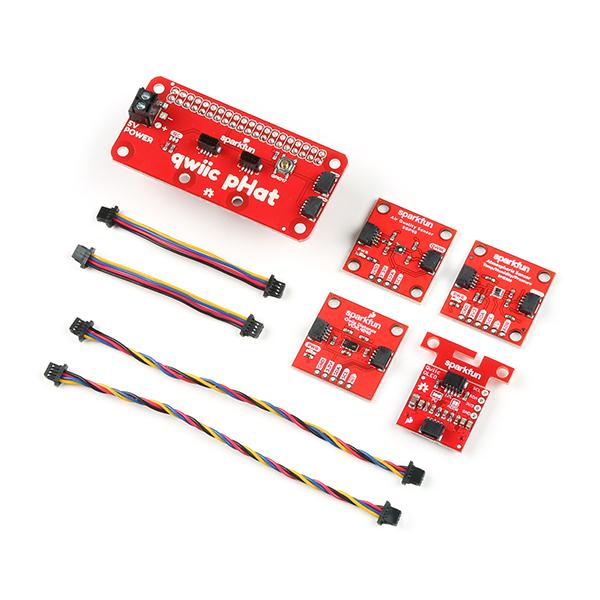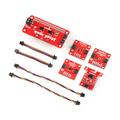SparkFun Qwiic Starter Kit for Raspberry Pi

Description
The SparkFun Qwiic Starter Kit for Raspberry Pi provides an opportunity to use Python to take sensor readings from each Qwiic-enabled board. You can measure proximity, ambient light, barometric pressure, humidity, temperature, and VOC Index. The readings can be displayed through the Micro OLED display or a monitor using the serial terminal. The kit can be used to create an Internet of Things (IoT) project by displaying the sensor data on a custom dashboard using Cayenne.
The Qwiic system simplifies I2C on your Raspberry Pi. All that is required is a Raspberry Pi with a 2x20 GPIO header to plug the HAT into. The kit is compatible with the NVIDIA Jetson Nano Developer Kit and Google Coral Development Board, as they use the same 2x20 GPIO header.
The SparkFun Qwiic Connect System is an ecosystem of I2C sensors, actuators, shields and cables that make prototyping faster and less prone to error. All Qwiic-enabled boards use a common 1mm pitch, 4-pin JST connector. This reduces the amount of required PCB space, and polarized connections mean you can’t hook it up wrong.
The SparkFun Qwiic Starter Kit for Raspberry Pi includes:
- 1x SparkFun Qwiic pHAT v2.0 for Raspberry Pi
- 1x SparkFun Micro OLED Breakout (Qwiic)
- 1x SparkFun Proximity Sensor Breakout - 20cm, VCNL4040 (Qwiic)
- 1x SparkFun Atmospheric Sensor Breakout - BME280 (Qwiic)
- 1x SparkFun Air Quality Sensor - SGP40 (Qwiic)
- 2x Flexible Qwiic Cable - 50mm
- 2x Flexible Qwiic Cable - 100mm
With this revision of the SparkFun Qwiic Starter Kit for Raspberry Pi V2, the SparkFun Environmental Combo Breakout - CCS811/BME280 (Qwiic) has been replaced with the SparkFun Air Quality Sensor - SGP40 (Qwiic). The BME280 is still included as a separate breakout board. Note that the SGP40 measures the VOC index as opposed to the CCS811 which measured the tVOC and eCO2.
Properties
| Brand | Sparkfun |
| Model | KIT-21285 |
| More info | Qwiic Kit for Raspberry Pi V2 Hookup Guide - SparkFun Learn |
| Length | 102 mm |
| Width | 131 mm |
| Height | 34 mm |
| Weight | 143 g |
Customer questions
Customer Reviews
- In stock Sparkfun Copper Tape - Conductive Adhesive, 5mm - 15 meter € 7,75 View product
- In stock Sparkfun Hobby Motor - Gear € 3,50 View product
- In stock Sparkfun Teensy Stackable Header Kit (Extended) € 2,90 View product
- In stock Sparkfun Battery Holder 2xAA with Cover and Switch - JST Connector € 2,60 View product
- In stock SparkFun Logic Level Converter - Bi-Directional € 5,15 View product
- Sale In stock -72 % Sparkfun EasyDriver - Stepper Motor Driver € 21,25 € 6,05 View product
- In stock Sparkfun Thin Speaker - 4 Ohm, 2.5W, 28mm € 3,- View product
- In stock Sparkfun Toggle Switch € 3,30 View product
- In stock Sparkfun Clear Plastic Knob € 1,75 View product
- In stock Sparkfun Jumper Wires - Connected 6" (M/M, 20 pack) € 5,10 View product
- In stock SparkFun Serial Basic Breakout - CH340G € 11,50 View product
- In stock SparkFun Audio Jack Breakout € 2,- View product
- In stock Sparkfun LED - Ultraviolet € 2,15 View product
- In stock Sparkfun Super Capacitor - 10F/2.5V € 6,25 View product
- In stock SparkFun Nano Power Timer - TPL5110 € 10,95 View product










